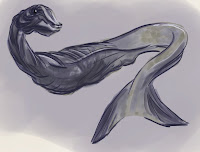Ziphius cavirostris
Cuvier's beaked whale.This animal most widely distributed of all the beaked whales. This animal is the only member of the genus Ziphius. Another common name for the species is goose-beaked whale because its head is said to be shaped like the beak of a goose. Georges Cuvier first described it in 1823 from part of a skull found in France in 1804. He thought it represented an extinct species it wasn't until the 1870s that it was realized the type specimen represented a living species.
The Ziphius cavirostris, also known as the Cuvier's beaked whale, is a species of beaked whale found in deep waters around the world. They are known to be elusive and difficult to study due to their deep-diving habits and remote habitats.
The Ziphius cavirostris is a medium-sized beaked whale, typically reaching lengths of about 7-8 meters (23-26 feet) and weigh around 6-7 tons. They have a dark gray to brown coloration on their dorsal side and a lighter gray on their ventral side. They have a distinctively hooked beak, giving them their name.
These whales are known to be deep divers, and they can reach depths of up to 2,000 meters (6,500 feet) and remain underwater for over an hour. They feed on a variety of deep-sea fish and squid, and they use echolocation to locate their prey.
Ziphius cavirostris are typically found in the open ocean, but they have been known to occur in coastal waters as well. They are found in all oceans of the world but mostly in the warmer regions. They are considered to be solitary animals and usually found in small groups of 2-4 individuals.
The population of Ziphius cavirostris is not well known, but they are considered to be a species of least concern by the IUCN. However, they may be affected by human activities such as pollution and noise pollution, especially military sonar, which can disorient and harm them.

I certainly agree to some points that you have discussed on this post. I appreciate that you have shared some reliable tips on this review.
ReplyDelete